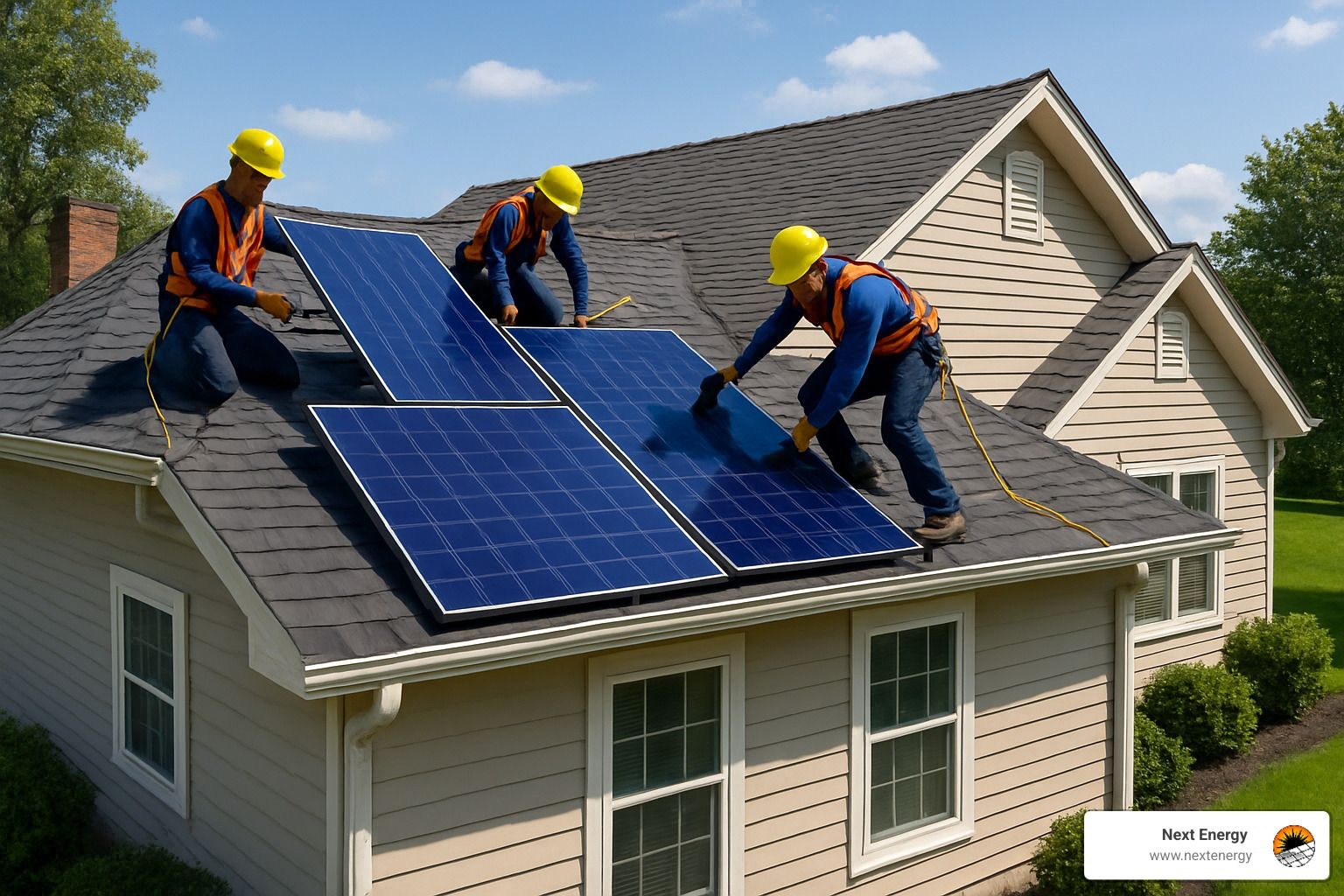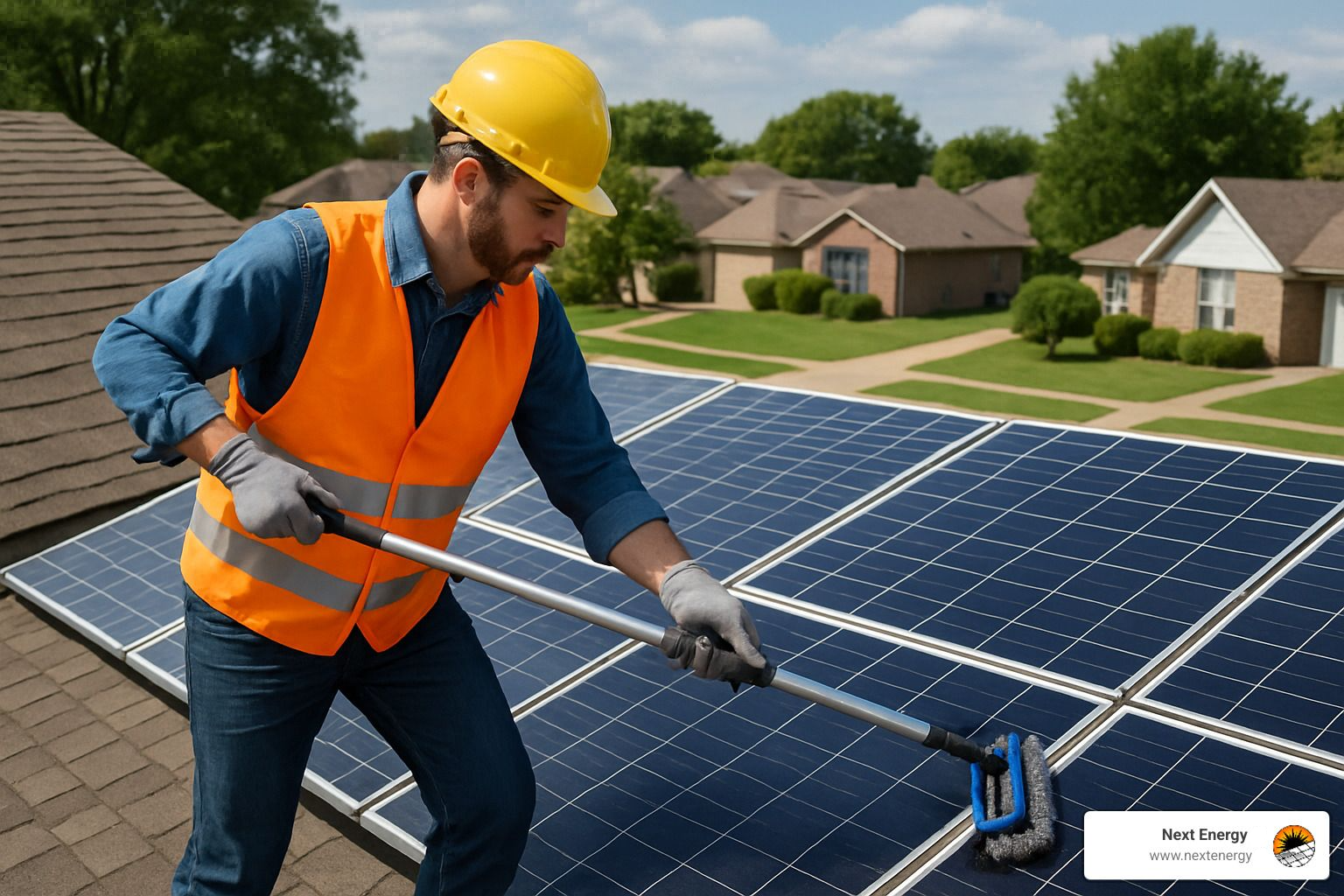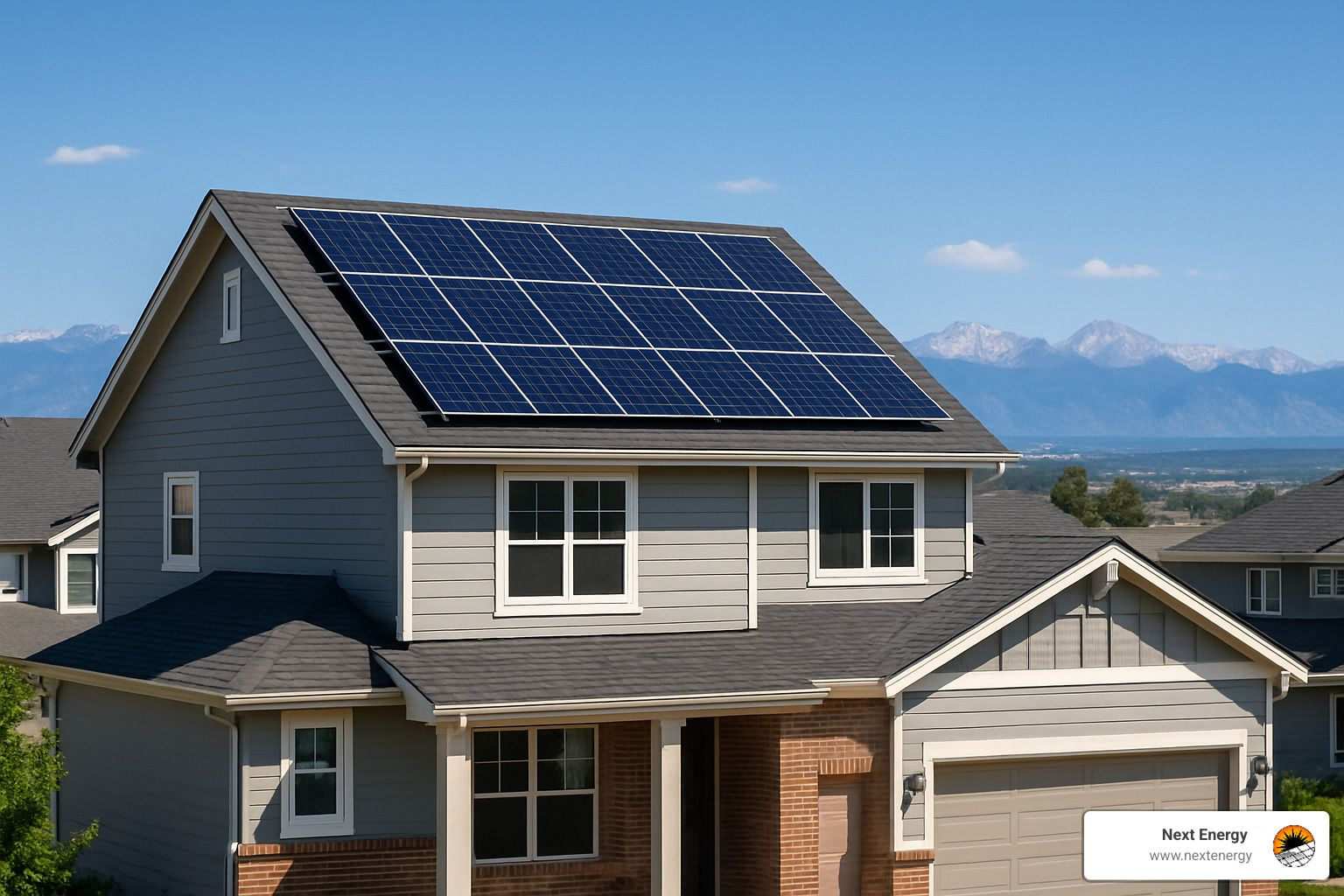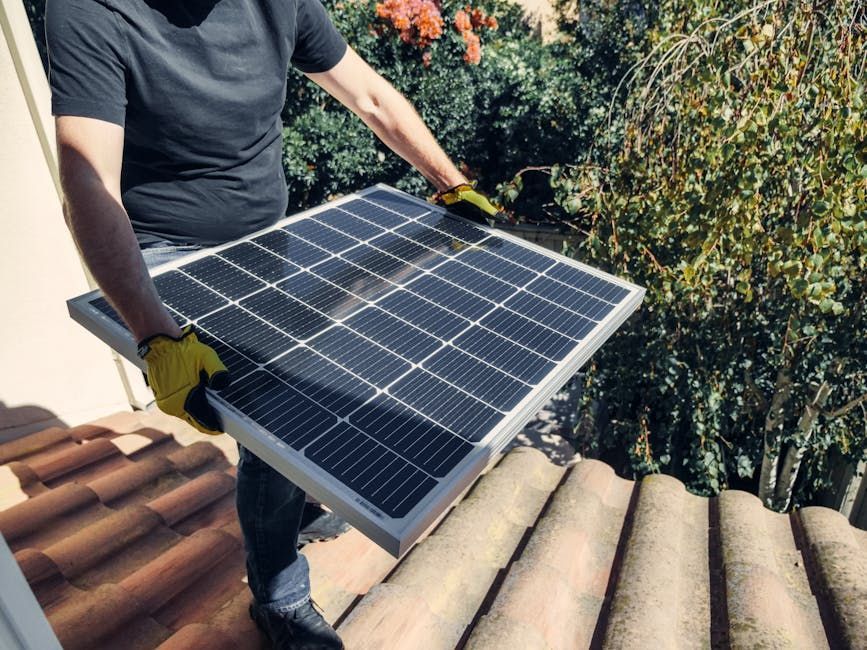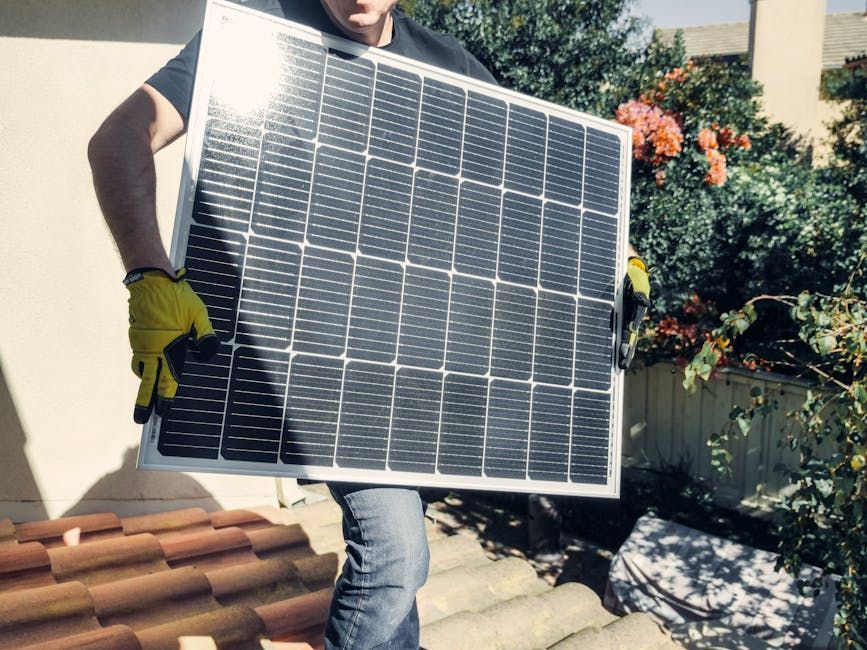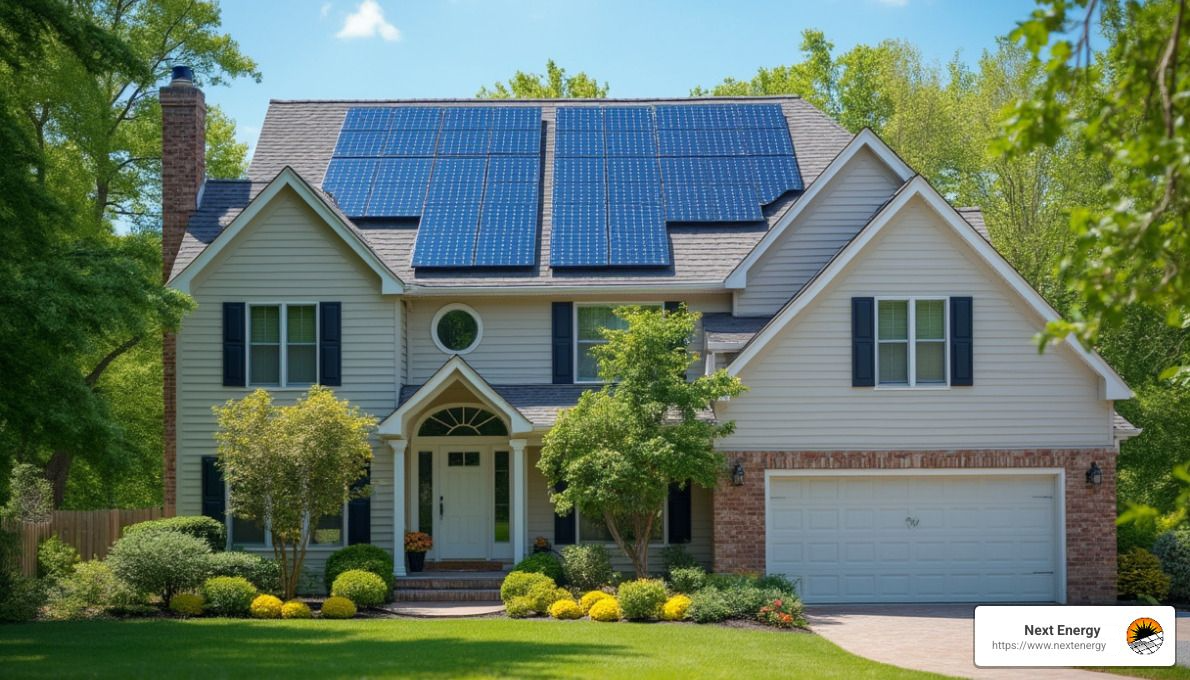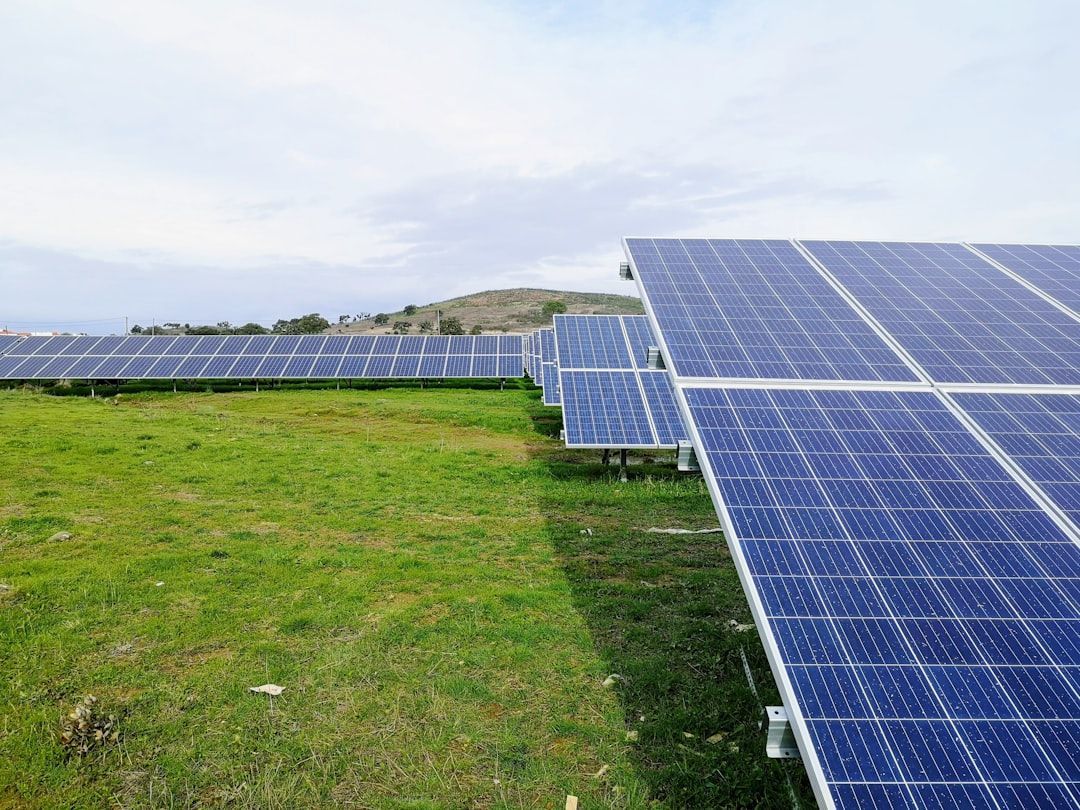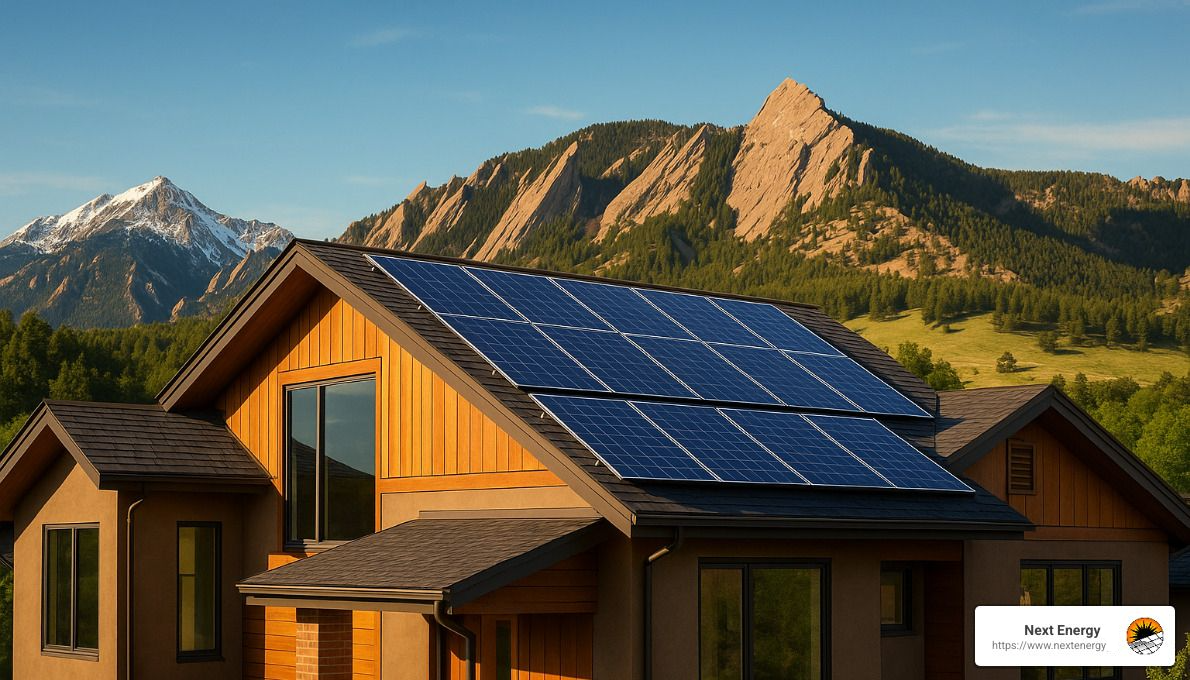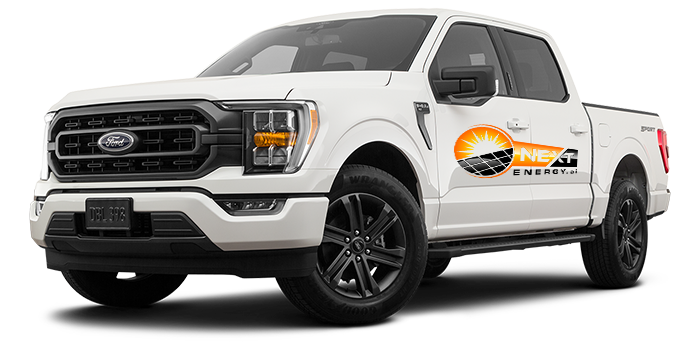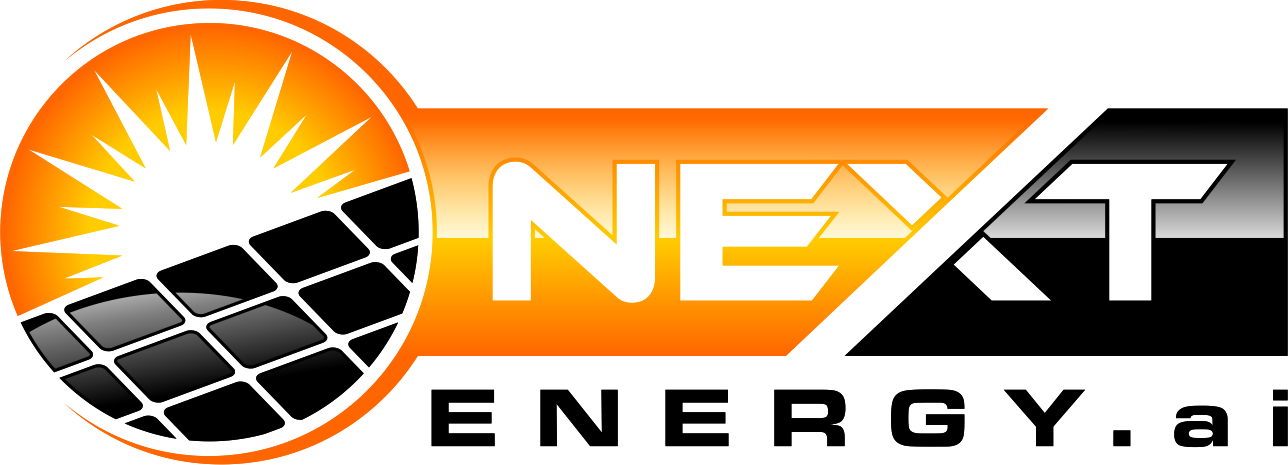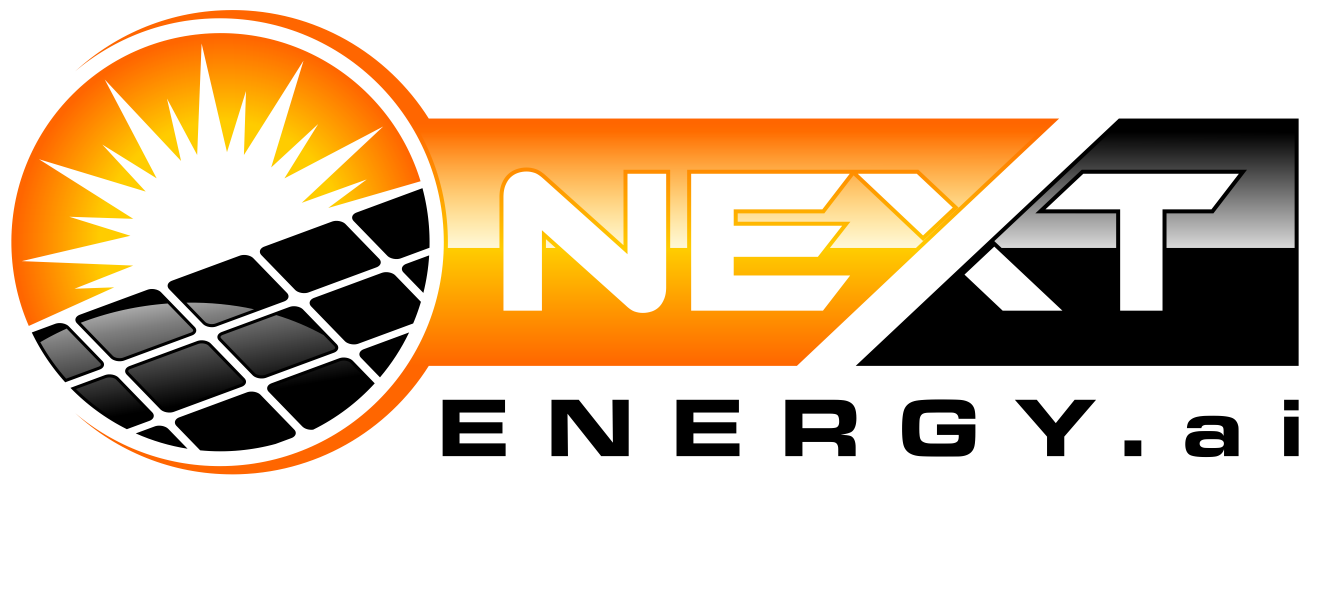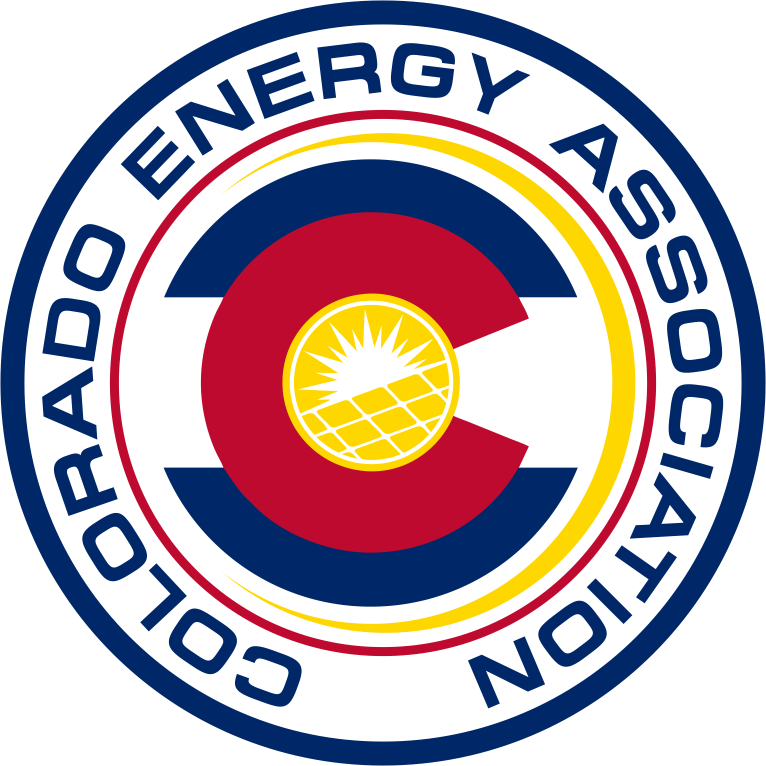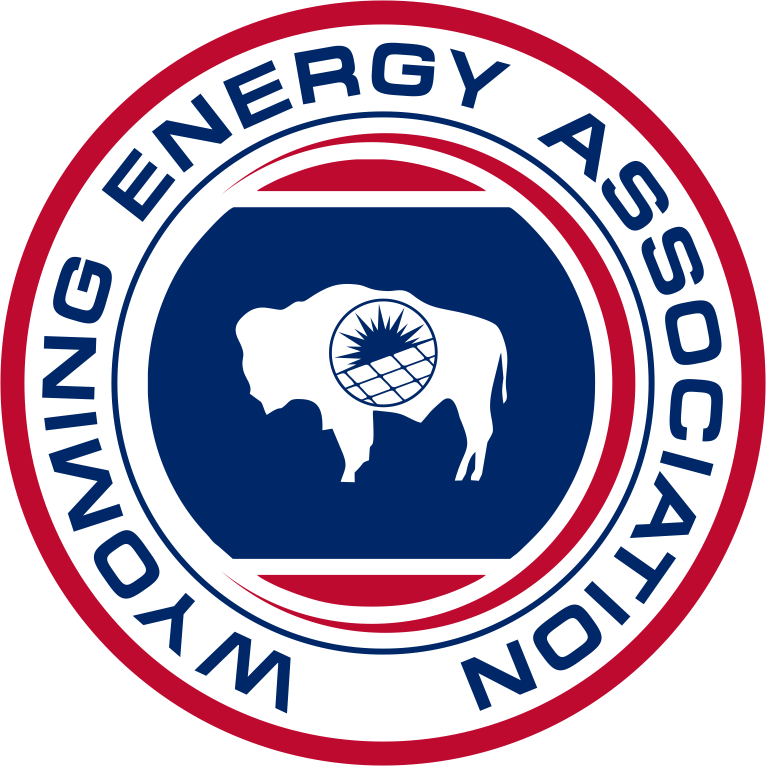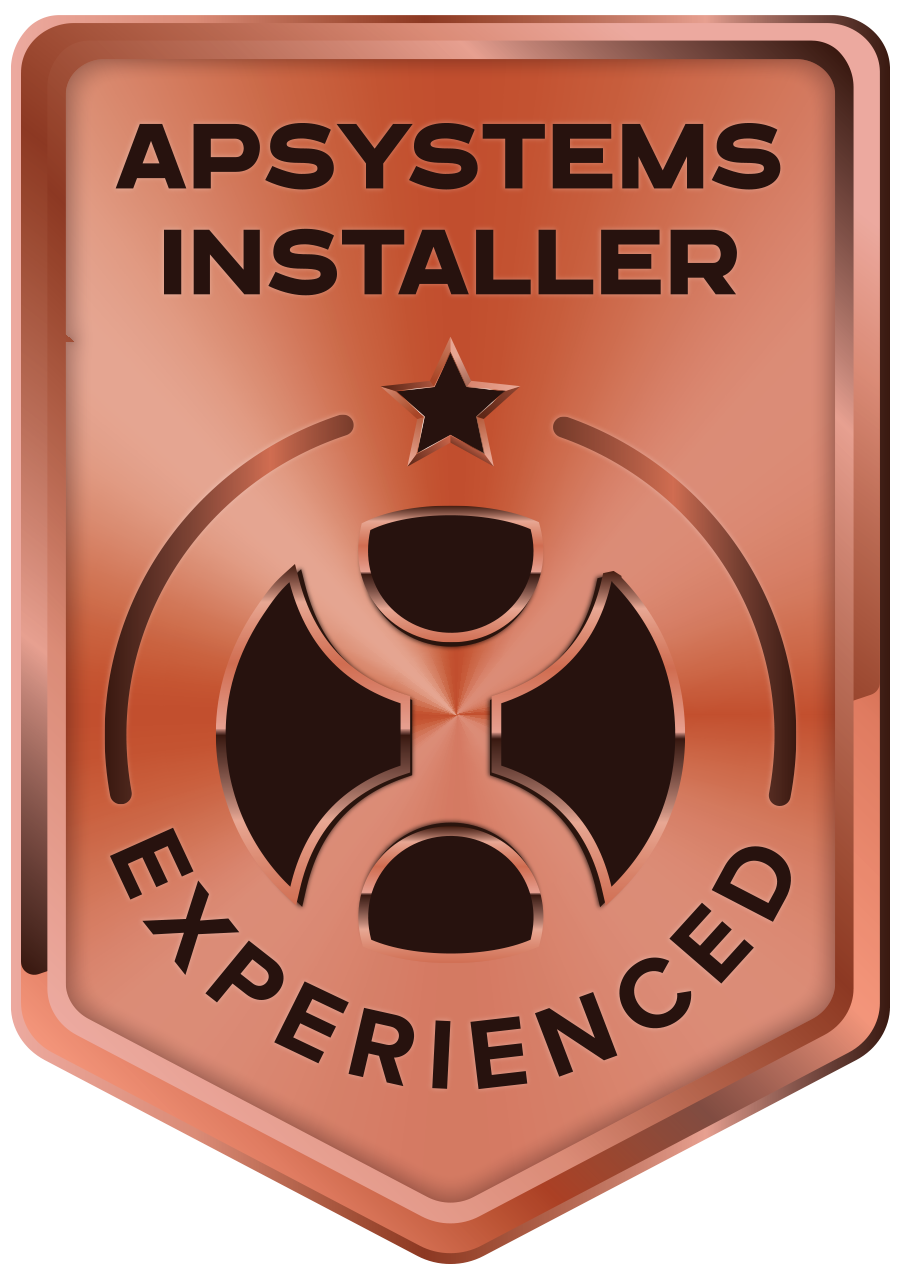Wyoming Solar Panel Pricing: What You Need to Know in 2025
What Wyoming Homeowners Need to Know About Solar Panel Costs
The average costs of solar panels in Wyoming range from $2.31 to $2.82 per watt in 2025, with total system costs as follows:
System Size: 5 kW
Before Tax Credit: $18,147
After 30% Tax Credit: $12,703
System Size: 10 kW
Before Tax Credit: $36,294
After 30% Tax Credit: $25,406
System Size: 11.91 kW
Before Tax Credit: $42,496
After 30% Tax Credit: $29,747
The costs of solar panels in Wyoming have fallen 43% over the last decade, making 2025 an excellent time to consider this investment. Wyoming's abundant sunshine (5.53 peak sun hours daily) creates favorable conditions for solar energy production, though many homeowners remain hesitant due to uncertainty about upfront expenses and long-term value.
I'm Spencer Gordon, CEO of NextEnergy, with NAPCEP certification in photovoltaics and extensive experience helping Wyoming homeowners steer the costs of solar panels in Wyoming to find sustainable energy solutions that deliver exceptional value.
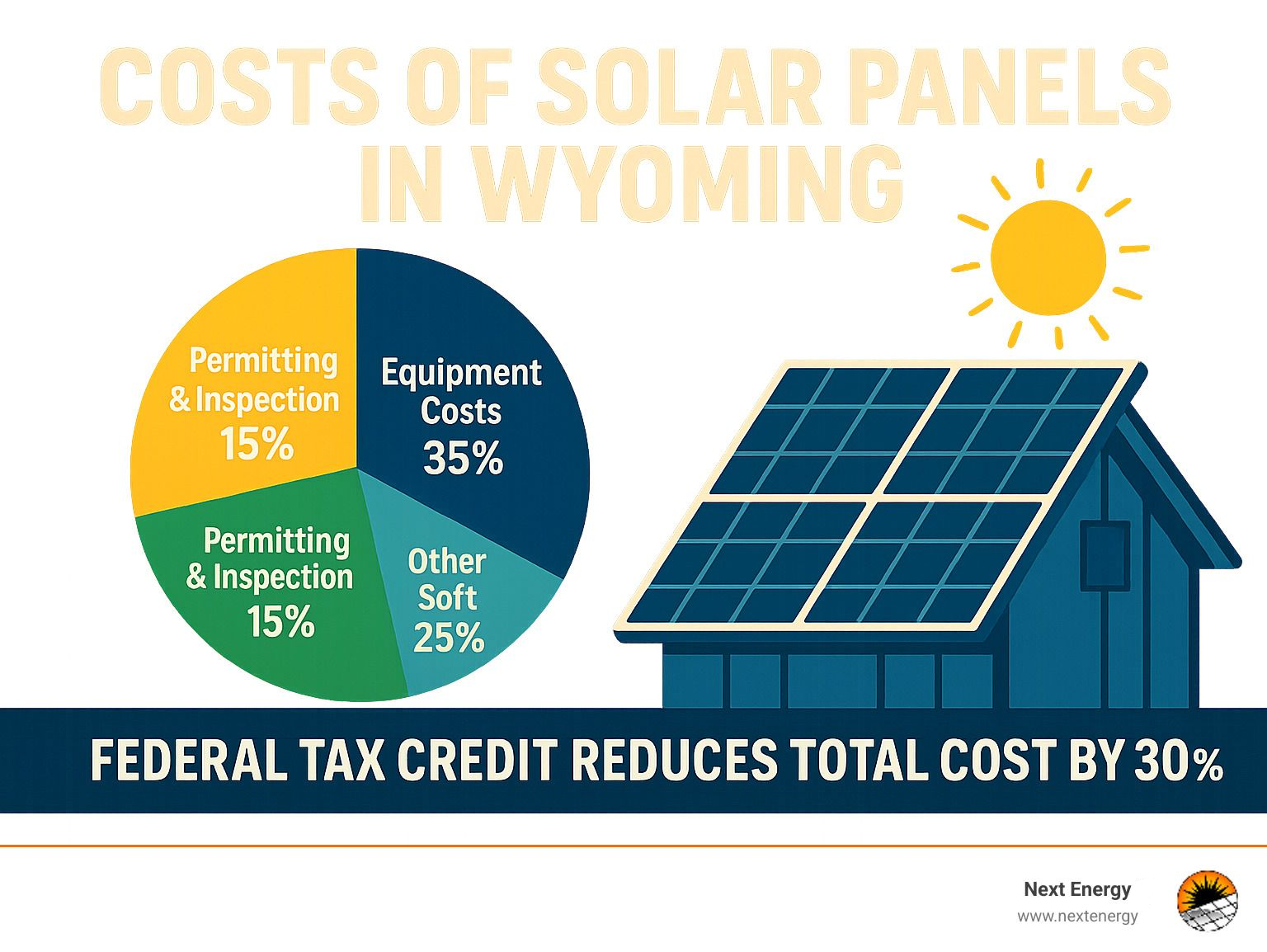
The 2025 Costs of Solar Panels in Wyoming
Good news, Wyoming homeowners! The sunshine state's abundant rays aren't just good for growing crops – they're becoming increasingly valuable for your wallet too. While Wyoming has been slower to jump on the solar bandwagon than some states, the financial picture in 2025 makes this an excellent time to reconsider.
As of June 2025, the average costs of solar panels in Wyoming have dropped to just $2.57 per watt – that's significantly below the national average of $3.00 per watt. For perspective, a standard 6 kW system will run about $15,420 before incentives, but drops to a much more attractive $10,794 after applying the federal tax credit.
This pricing advantage isn't just luck – it stems from Wyoming's lower labor costs, more streamlined permitting processes in many counties, and a growing community of experienced installers serving our region.
"I've watched installation costs of solar panels in Wyoming literally cut in half over the last decade," explains our lead solar designer at Next Energy, "What would have cost you $4.50 per watt back in 2015 is now just over half that price – and the technology just keeps getting better!"
How much do the costs of solar panels in Wyoming differ from 2024 to 2025?
The downward price trend continues to benefit Wyoming homeowners. In 2024, you would have paid approximately $2.70 per watt, compared to 2025's $2.57 – that's roughly a 5% year-over-year decrease.
This continued price drop comes from several factors working in your favor. Modern panels are more efficient, producing more power per square foot and reducing the total number needed. Supply chains have finally stabilized after years of pandemic disruptions. More solar companies now serve Wyoming markets, creating healthy competition. And as installation volumes increase, companies like ours can negotiate better equipment pricing through bulk purchasing.
For the average Wyoming home needing an 11.91 kW system, this price reduction translates to approximately $1,500 in savings compared to what you would have paid in 2024. While equipment costs aren't falling as dramatically as they did from 2010-2020, we're still seeing meaningful reductions in "soft costs" like permitting, customer acquisition, and installation efficiency.
How system size shapes the costs of solar panels in Wyoming
One of the biggest factors affecting your total investment is simply how big a system you need. While the average Wyoming home requires an 11.91 kW system to offset 100% of electricity usage, your specific needs may vary significantly based on your energy consumption, available roof space, and budget.
The good news? Bigger systems offer better value per watt:
This "bulk discount" effect means doubling your system size won't double your cost. For example:
- A 4 kW system typically costs around $2.82/watt ($11,280 total)
- An 8 kW system drops to about $2.65/watt ($21,200 total)
- A 12 kW system can go as low as $2.51/watt ($30,120 total)
This scaling effect is why many of our Wyoming customers choose to size their systems to cover their full electricity needs rather than just a portion. Each additional panel becomes more economical as your system grows larger.
That said, right-sizing matters. Going too big beyond what your utility will allow for net metering (typically capped at your historical usage) might not be financially optimal, as excess production might be compensated at lower rates. We'll help you find that sweet spot for maximum savings.
Incentives, Tax Credits & Net Metering
When looking at the true costs of solar panels in Wyoming, the sticker price is just the beginning of the story. The various incentives available can dramatically reduce what you'll actually pay – turning what might seem expensive into a genuinely smart investment.
The crown jewel of solar incentives remains the federal Residential Clean Energy Credit (previously called the Investment Tax Credit). This program puts 30% of your total solar investment right back in your pocket through a dollar-for-dollar reduction of your federal taxes. This generous credit isn't going anywhere soon – it's locked in at 30% through 2032, before stepping down to 26% in 2033 and 22% in 2034.
"The tax credit is often the tipping point that makes solar financially viable for our Wyoming customers," says our lead solar consultant. "That 30% reduction is substantial – on a typical $30,000 system, that's $9,000 back in your pocket."
The beauty of a tax credit (versus a deduction) is that it directly reduces what you owe the IRS. Can't use the full credit this year? No problem – you can roll over any unused portion to future tax years until you've captured the full benefit.
Wyoming homeowners have additional opportunities to reduce their costs of solar panels in Wyoming:
Rural homeowners and agricultural businesses should check out the USDA Rural Energy for America Program (REAP), which can cover up to 25% of project costs through grants. The Wyoming Energy Authority occasionally rolls out specialized renewable energy programs worth investigating. Some local utilities also offer their own rebates or incentives – it's always worth asking your utility what they provide.
Wyoming's net metering law rounds out the incentive package, requiring utilities to offer credit for excess electricity your system produces (for systems up to 25 kW). This effectively turns the grid into your personal battery, storing your solar overproduction as credits for later use.
Altogether, these incentives can slash the effective costs of solar panels in Wyoming by 30-50%. That's the difference between a 12-year payback period and one that's just 6-8 years. Want to dig deeper into the financial picture? Our guide on Are Solar Panels Worth It in Wyoming? offers a comprehensive analysis.
How the Residential Clean Energy Credit lowers the costs of solar panels in Wyoming
The federal solar tax credit works in refreshingly simple terms. You install your system, pay the full amount upfront (or finance it), and then claim 30% of the total cost when filing your federal taxes.
Let's make this concrete. Say you install an 11.91 kW system for $42,496 (typical for many Wyoming homes). Your tax credit would be a whopping $12,749. If your federal tax bill that year is $8,000, it's completely wiped out. The remaining $4,749? It carries forward to next year's taxes.
What many homeowners don't realize is just how comprehensive this credit is. It doesn't just cover the panels – it includes everything related to your solar installation:
- The solar panels themselves
- Inverters and power electronics
- Mounting hardware
- Battery storage (if charged primarily by your solar system)
- All labor costs
- Permits and inspection fees
- Monitoring equipment
To claim your credit, you'll file IRS Form 5695 with your tax return. While the form isn't overly complex, we typically recommend touching base with your tax professional to ensure you're maximizing this substantial benefit.
"I've had clients save over $15,000 through this tax credit alone," notes our solar finance specialist. "It's not a rebate – you do need to have tax liability to use it – but for most working homeowners, it's essentially a 30% discount on going solar."
Net metering mechanics for Wyoming homeowners
Net metering might sound technical, but it's actually a straightforward concept that dramatically improves the economics of solar. Think of it as your utility keeping a running tab of the electricity you contribute versus what you consume.
In Wyoming, state law requires utilities to offer net metering for home systems up to 25 kilowatts. Here's how it works in practical terms:
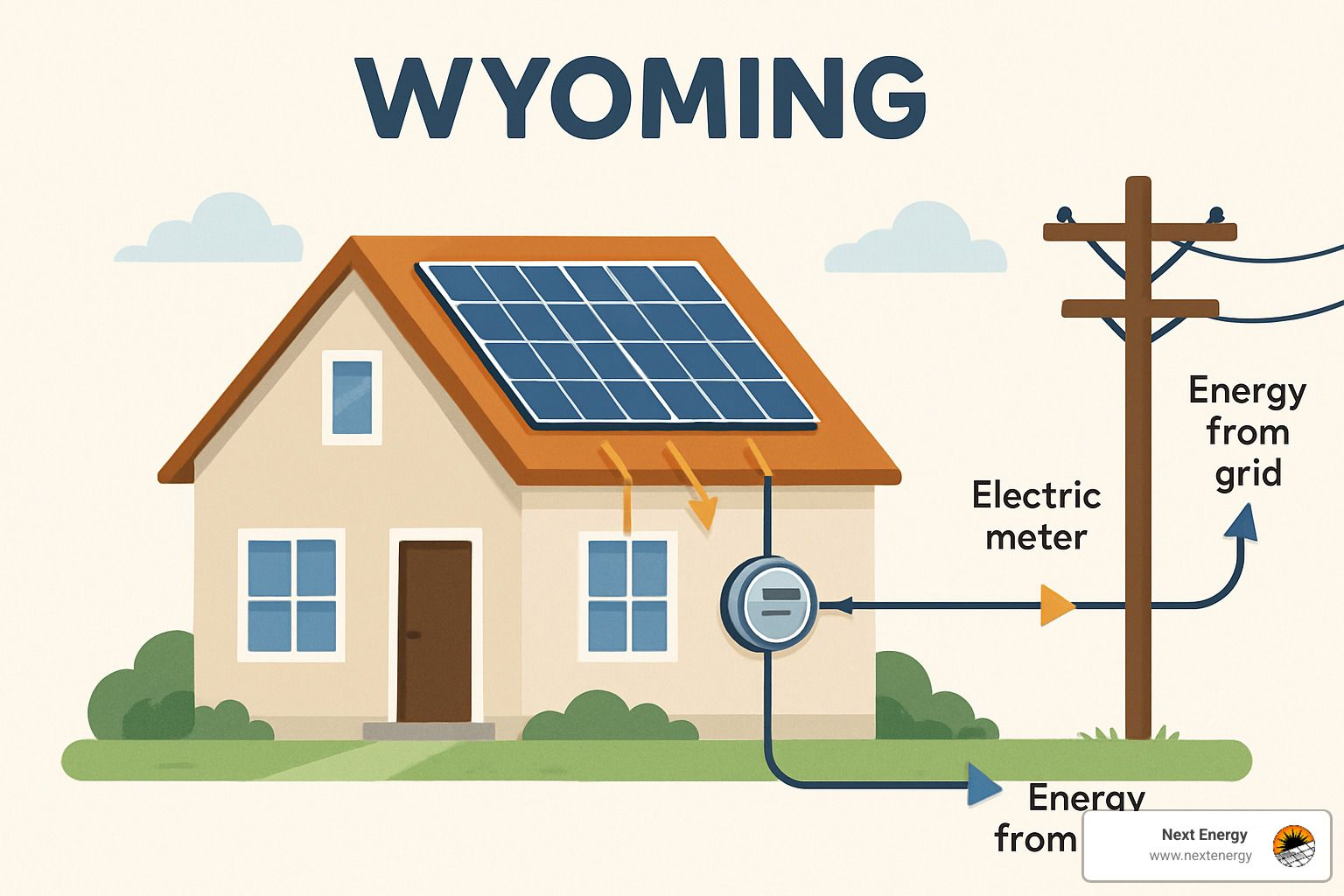
On sunny days when your panels produce more electricity than your home uses, that excess flows back to the grid, spinning your meter backward. Your utility tracks these contributions as credits on your bill. These credits roll over month to month, allowing you to build them up during the sunny summer to use during darker winter months.
Once a year (typically on your connection anniversary), any unused credits get "trued up." At this point, Wyoming utilities typically pay you for excess generation at their "avoided cost" rate – usually lower than the retail rate you pay for electricity.
"The beauty of net metering is that it lets you use the grid like a giant battery," explains our system designer. "You bank credit when the sun is shining and withdraw it when you need it, without having to install physical batteries."
Each Wyoming utility handles the specifics slightly differently. Rocky Mountain Power credits excess generation at retail rates up to 100% of your consumption. Black Hills Energy factors in time-of-use considerations. Rural electric cooperatives may have their own variations on the policy.
While Wyoming's approach isn't as generous as states that pay full retail rates indefinitely for all excess generation, it still allows properly-sized systems to offset nearly all of your electricity costs. That's a major factor in reducing the effective costs of solar panels in Wyoming over the long term.
Payback, Savings & Home Value
When you're considering the costs of solar panels in Wyoming, looking at the long-term financial picture really tells the complete story. Solar isn't just something you spend money on—it's more like planting a money tree in your yard that grows over time.
Most Wyoming homeowners see their solar investment pay for itself in about 8-14 years, depending on your specific situation. This "payback period" is simply how long it takes for your energy bill savings to equal what you initially spent.
Let's make this real: If you live in Cheyenne and install that average 11.91 kW system at $29,747 (after the tax credit), you'd likely save around $2,400 yearly on electricity. Do the math, and you're looking at roughly 12.4 years until payback. But here's the beautiful part—after that point, you're essentially getting free electricity for the next 15+ years of your system's life!
Right from the start, you'll notice your electric bills drop by about 40-60%. That immediate relief feels great, but the long-term view is even better. Over 25 years, the typical Wyoming solar homeowner saves approximately $7,605 compared to staying with utility power.
What makes solar particularly smart as an investment is what energy experts call the "levelized cost of energy" or LCOE—basically, what each kilowatt-hour actually costs you over the system's lifetime. In Wyoming, solar-produced electricity runs about 5.7 cents per kWh, while utility electricity averages around 23.0 cents per kWh over that same 25-year period (accounting for those typical 3-4% annual rate hikes we all dread).
Your home's value gets a nice boost too. Solar panels typically increase property values by 3-4%, according to studies from the Lawrence Berkeley National Laboratory. Homes with owned solar systems sell for a premium of about $4,000 per installed kilowatt. For that typical Wyoming system of 11.91 kW, we're talking about potentially adding $47,640 to your home's value!
And let's not forget the planet. That same 11.91 kW system offsets roughly 17,693 kWh of grid electricity annually, preventing about 12.5 metric tons of CO2 from entering the atmosphere each year. That's like planting 206 trees every single year. Your grandkids will thank you.
25-year savings scenarios
Let's break down how the numbers might look over 25 years with different approaches to going solar.
For a typical 11.91 kW Wyoming system, here's what you might expect:
If you purchase with cash and utility rates increase at the historical average of 3.5% annually, you're looking at an initial investment of $29,747 (after tax credit), total electricity savings of $89,700, and net savings of $59,953 over 25 years. That's a 7.6% internal rate of return—better than many traditional investments!
Financing changes the picture a bit. With a 20-year solar loan at 5.99% APR and no money down, you'd pay about $50,990 in loan payments but save $89,700 on electricity, netting you $38,710 in savings with a 6.2% return.
Even if utility rates increase more slowly at 2.5% annually, a cash purchase still nets you $41,613 in savings over 25 years with a 6.3% return.
Most homeowners reach their breakeven point—when savings have fully covered the initial investment—between years 8 and 14. Cash purchases typically break even faster than financed systems, but both approaches lead to substantial long-term savings.
Do solar panels raise property values in Wyoming?
The evidence is clear: solar panels boost Wyoming home values. The exact premium varies by location and system characteristics, but the trend is consistently positive.
The U.S. Department of Energy's Lawrence Berkeley National Laboratory found that homes with owned solar systems sell for approximately $4,000 more per kilowatt of installed capacity. That's a significant boost to your property value!
Several factors influence just how much value your solar system adds:
System ownership matters tremendously. Owned systems (whether purchased outright or through a loan) add substantially more value than leased systems. In fact, some leased systems can actually complicate the home selling process.
Newer systems naturally command higher premiums than older ones, as buyers recognize they'll enjoy more years of free electricity.
Larger, more productive systems generally add proportionally more value, as they offset more of the home's energy needs.
As local awareness grows, so does the premium. "We're seeing more buyers specifically asking about homes with solar," a Cheyenne realtor recently told us. "They understand the long-term savings and are willing to pay more upfront for those benefits."
It's worth noting that Wyoming doesn't currently offer a property tax exemption for solar installations, so your increased home value might result in slightly higher property taxes. However, this increase is typically minimal compared to the overall financial benefits you'll enjoy from your solar investment.
Cost Drivers & System Sizing
When you're considering solar for your Wyoming home, understanding what affects the costs of solar panels in Wyoming helps you make smarter decisions and potentially find ways to save. Let's break down what really influences your final price tag.
The technology inside your panels makes a big difference. In 2025, standard panels typically generate between 380-420 watts each, while premium models can pump out over 450 watts per panel. More efficient panels mean more power from the same roof space – but they'll cost you more upfront.
Your roof itself plays a surprisingly important role too. A simple, south-facing roof with minimal obstructions will be much more affordable to outfit than a complex roof with multiple angles or obstacles. This affects both installation time and materials needed.
Good news for Wyoming homeowners – installation labor typically makes up 25-30% of your total system cost, and our state's labor rates tend to be lower than the national average. This helps keep Wyoming's solar pricing competitive.
The paperwork and red tape vary widely across the state. Some counties have created streamlined solar permitting processes, while others still have more complex requirements that add time and expense. When you work with an experienced local installer, they'll handle these "soft costs" efficiently.
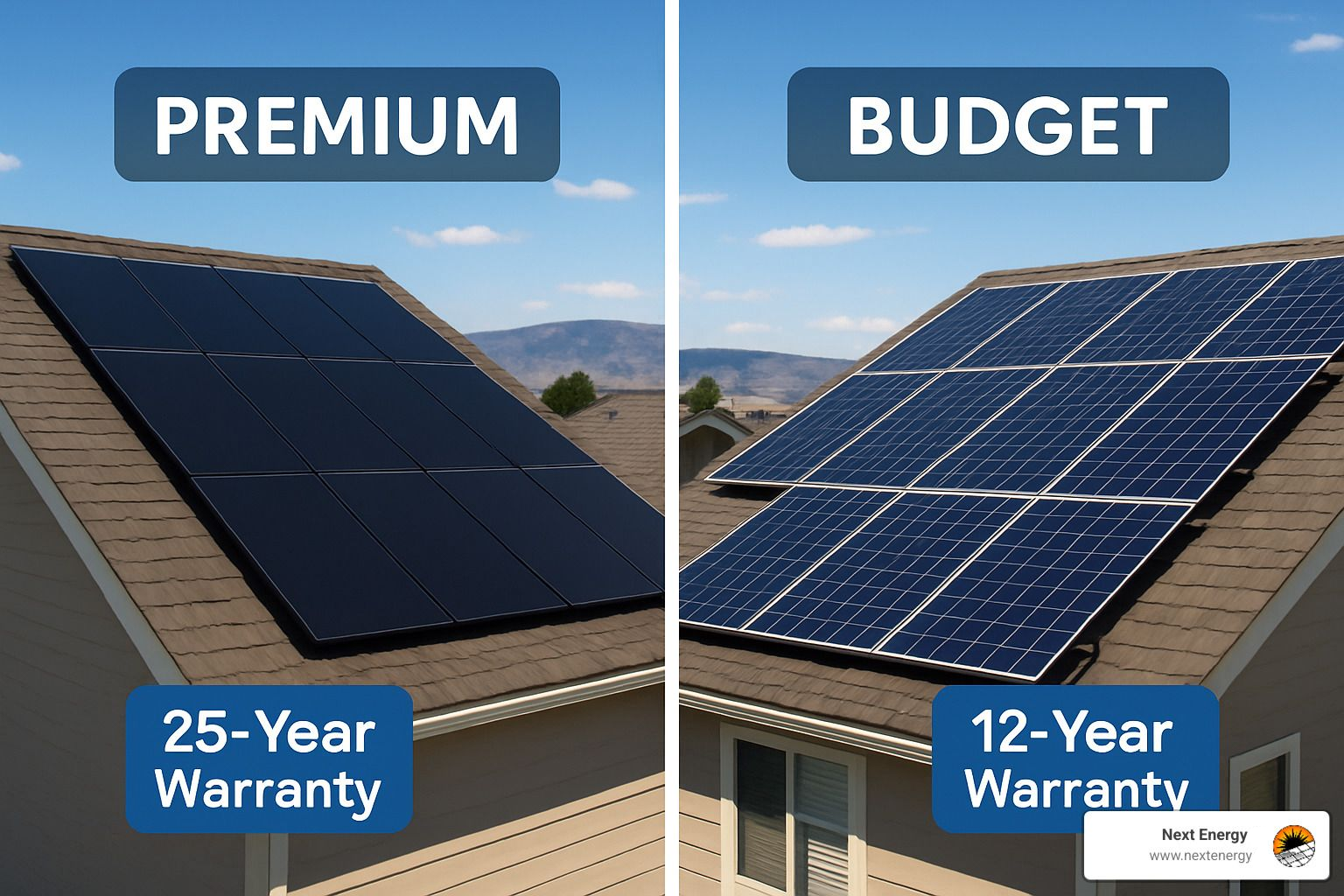
Don't overlook the mounting hardware – it matters more than you might think. Premium racking systems cost more initially but offer better protection against Wyoming's sometimes harsh weather conditions, including heavy snow loads and high winds.
The type of inverter you choose affects both cost and performance. String inverters are the budget-friendly option, while microinverters or power optimizers cost more but can significantly increase production, especially if parts of your roof experience partial shading.
Getting the right system size is crucial for maximizing your investment. The average Wyoming home needs about an 11.91 kW system to offset 100% of electricity usage, but your specific needs will depend on your energy consumption patterns.
To properly size your system, we look at:
- Your past year of electricity usage in kilowatt-hours
- Your roof's solar potential (available space, orientation, shading)
- Your budget and financial goals
- Local net metering policies
With Wyoming's abundant sunshine providing an average of 5.53 peak sun hours daily, each kilowatt of installed solar capacity generates approximately 2,019 kWh annually. This makes it possible to reliably offset your electricity bills while maximizing your financial returns.
Equipment quality vs budget modules
When shopping for solar panels, Wyoming homeowners often wonder whether premium panels are worth the extra cost. It's an important decision that affects both your upfront investment and long-term performance.
Premium solar panels from manufacturers like SunPower, REC, and Panasonic offer higher efficiency ratings (20-22.8%), which means they convert more sunlight into electricity. They also degrade more slowly over time (0.25-0.3% annually versus 0.5-0.7% for budget panels) and typically come with longer warranties of 25-30 years. These high-end panels often perform better in Wyoming's variable climate conditions and look more sleek on your roof.
Budget-friendly modules from companies like Canadian Solar, Trina, and LONGi cost 20-30% less per watt but still offer decent efficiency (18-19%). Their warranties are shorter (typically 12-15 years), but they can provide acceptable performance for most homes and sometimes offer faster payback periods.
The price gap between these options has narrowed recently. In 2025, premium panels in Wyoming typically cost $2.70-$2.95 per watt installed, while budget options range from $2.31-$2.55 per watt.
Your inverter choice follows similar patterns. Premium options from SolarEdge and Enphase offer better monitoring, longer warranties, and panel-level optimization compared to more basic string inverters.
Are premium modules worth the added costs of solar panels in Wyoming?
Whether it makes sense to spend more on premium equipment really depends on your specific situation. If you're planning to stay in your home for 15+ years, the longer lifespan and slower degradation rate of premium panels often justify their higher price tag. For a typical 11.91 kW Wyoming system, premium panels might generate an additional 18,000-25,000 kWh over 25 years compared to budget alternatives – that's real value.
If your roof space is limited, higher-efficiency premium panels can generate more power from the same footprint, sometimes making them the only practical option to meet your energy needs.
Wyoming's climate deserves special consideration too. Our temperature extremes, heavy snow loads, and occasional hail can be tough on solar equipment. Premium panels generally handle these challenges better, with improved performance in extreme temperatures and greater durability against environmental stresses.
Aesthetics matter to many homeowners. Premium panels typically offer a more uniform, sleeker appearance that looks better on street-facing roof sections. And if you're thinking about resale value, higher-quality solar equipment may contribute more to your home's value appreciation, particularly in growing Wyoming markets like Cheyenne and Laramie.
For most Wyoming homeowners, we find that mid-tier panels offer the best balance of quality and value in 2025. They provide a sweet spot of performance, durability, and cost. However, those with specific constraints or long-term perspectives often benefit from investing in truly premium equipment.
Each year, solar panels get more and more efficient, so the technology you choose today will affect your energy production for decades to come.
Financing, Installation Timeline & FAQs
When it comes to managing the costs of solar panels in Wyoming, you've got several financing paths to choose from, each with its own set of advantages.
A cash purchase is the most straightforward approach. You pay for everything upfront, claim your 30% federal tax credit when you file your taxes, and the system is yours free and clear. This option delivers the highest long-term returns and immediately adds the full value to your home.
"Many of our customers are surprised to learn they don't need to have the full amount saved up to go solar," says our finance specialist. "Solar loans have really opened up access for Wyoming homeowners."
Solar loans have become increasingly popular, with terms ranging from 5-20 years and often requiring little to no money down. The beauty of these loans is they can be structured so your monthly payment is less than what you were paying the utility company, creating positive cash flow from day one. And that 30% federal tax credit? You can use it to pay down the loan principal if you'd like.
If you've built up equity in your home, a Home Equity Loan or HELOC might be your best bet. These typically offer lower interest rates than dedicated solar loans and may provide tax-deductible interest. They do use your home as collateral, but if you've got the equity, they're worth considering.
While PACE financing has helped homeowners in other states, it's not currently available for residential properties in Wyoming. We're keeping an eye on policy changes that might bring this option to Wyoming in the future.
At Next Energy, we've developed smart tools powered by artificial intelligence to help determine the perfect system size and financing structure for your specific situation. Our analysis looks at your energy usage patterns, roof characteristics, available incentives, and financial situation to recommend the most beneficial approach.
From first conversation to flipping the switch, the solar installation process in Wyoming typically takes 2-6 months. Here's what to expect:
We'll start with an initial consultation and site assessment (1-2 weeks), where we evaluate your energy needs, roof condition, and solar potential. Then we move to system design and proposal (1-2 weeks), creating a customized system design just for your home.
The permitting and utility approval stage (3-8 weeks) often takes the longest, as we secure necessary permits from your local jurisdiction and approval from your utility company. The actual installation is surprisingly quick – typically just 1-3 days depending on system size and complexity.
After installation, your system needs inspection and interconnection (2-4 weeks), where local authorities inspect the work and your utility connects you to the grid. Finally, we activate your system and set up monitoring (1 day), so you can start tracking your production immediately.
We exclusively work with NABCEP-certified installers throughout Wyoming, ensuring your installation meets the highest quality standards. These certified professionals have demonstrated expertise in solar PV system design and installation, giving you peace of mind that your system will be installed correctly and safely.
Are low-interest loans reducing the costs of solar panels in Wyoming?
The solar financing landscape in Wyoming has evolved dramatically in recent years, with attractive loan options now making solar accessible to many more homeowners.
In 2025, solar loan interest rates typically range from 4.99% to 8.99%, varying based on your credit score, chosen loan term, and lender. Many of these loans require no down payment and have no early repayment penalties – flexibility that homeowners appreciate.
Let's look at a real-world example: Say you're installing an 11.91 kW system costing $42,496 ($29,747 after the tax credit). You might choose a 15-year solar loan at 5.99% APR with nothing down. Your monthly payment would be about $249.
Compare that to the average monthly electricity bill of $200 that your new system would offset. Initially, you'd see a small negative cash flow of $49 monthly. But here's where it gets interesting – as utility rates climb (historically about 3.2% annually in Wyoming), this equation flips to positive cash flow, typically within 3-5 years.
"We're seeing more local credit unions offering specialized 'green energy' loans with preferential rates," notes our financing team. "It's a trend that's making solar more affordable for Wyoming families."
The Inflation Reduction Act of 2022 provided funding for state energy offices to develop loan programs that may further improve solar loan terms in coming years. The key benefit of these low-interest solar loans is simple – they let you go solar with little or no money down while still receiving the full 30% federal tax credit and all the long-term benefits of ownership.
Installation roadmap: from quote to PTO
The journey from your initial solar quote to receiving permission to operate (PTO) involves several key milestones. Understanding this process helps set realistic expectations and ensures your solar experience goes smoothly.
We start with a site survey and system design in weeks 1-2. This includes a detailed roof assessment, shading analysis, electrical panel evaluation, and creating a system design customized to your energy needs.
By week 3, we'll handle contract signing and initial payment, typically 10-30% of the system cost. We'll also submit any applicable rebate applications on your behalf.
Weeks 4-10 focus on engineering and permitting. This includes structural engineering review, creating electrical diagrams and site plans, submitting everything to your local building department, and securing HOA approval if needed.
Concurrently, we submit your utility interconnection application, obtain preliminary approval, and request any necessary meter changes. We manage this entire process so you don't have to steer the utility bureaucracy.
The actual installation happens around weeks 11-12. We'll prepare your roof, install the mounting system, place and wire the panels, install the inverter, and thoroughly test everything. Our installation teams are known for their attention to detail and clean work sites.
Next come the inspections in weeks 13-14. Both your local building department and possibly your utility will inspect the system to ensure everything meets code requirements.
Around weeks 15-16, you'll receive permission to operate from your utility, along with any necessary meter installation or programming. This is when your system officially goes live and starts generating clean electricity.
Finally, in week 17, we handle monitoring setup and orientation, configuring your monitoring system, showing you how everything works, and providing complete documentation. You'll know exactly how to track your system's performance and understand what all those numbers mean.
"The day we activate a customer's system is always special," says our lead installer. "Seeing their face when they realize they're now producing their own power – that moment never gets old."
Frequently Asked Questions about the Costs of Solar Panels in Wyoming
Q: How many peak sun hours does Wyoming receive?
A: Wyoming enjoys an impressive average of 5.53 peak sun hours daily – well above the national average. This abundant sunshine makes our state surprisingly well-suited for solar energy production despite our northern latitude. These hours vary seasonally, with summer days providing up to 7 hours and winter days typically offering 3-4 hours.
Q: What is the typical system size needed for a Wyoming home?
A: The average Wyoming home requires an 11.91 kW system to offset 100% of electricity usage. That said, we see installations ranging from 5 kW to 15 kW depending on specific needs. Energy-efficient homes with good insulation might need smaller systems, while larger homes or those with electric heating often require more capacity. Our AI-powered assessment tools help determine your ideal system size based on your actual energy consumption patterns.
Q: How much do battery add-ons increase the costs of solar panels in Wyoming?
A: Adding battery storage to your Wyoming solar system typically adds $10,000 to $20,000, depending on capacity and features. A standard 10 kWh battery system costs approximately $12,000 before incentives, or about $8,400 after applying the 30% federal tax credit.
The good news is batteries qualify for the same 30% tax credit as the solar panels themselves, as long as they're installed within the same tax year or charged primarily by solar. While not every homeowner needs battery backup, those in areas with frequent power outages or those wanting to maximize self-consumption find the additional investment worthwhile.
Q: Does Wyoming offer state tax credits or rebates for solar installations?
A: Currently, Wyoming doesn't offer state tax credits or rebates specifically for residential solar installations. The federal 30% tax credit remains the primary incentive for Wyoming homeowners. Some utilities or local jurisdictions may offer additional incentives, and the Wyoming Energy Authority occasionally provides grants for renewable energy projects, though these typically focus on commercial or community-scale installations rather than residential systems.
Q: How do Wyoming's electricity rates affect solar payback periods?
A: Wyoming's relatively low electricity rates (averaging about $0.11 per kWh as of 2025) do result in longer payback periods compared to states with higher electricity costs. This extends the time to recoup your investment to 8-14 years for most homeowners.
However, looking only at current rates misses an important factor – utility rates have historically increased by 3.2% annually in Wyoming. This rate inflation significantly improves the long-term economics of solar, especially when viewing it as the 25+ year investment it truly is. Think of solar as locking in your electricity rates for the next quarter-century.
Q: Are there any hidden costs I should be aware of?
A: We believe in complete transparency, so here are potential additional expenses to consider:
If your roof needs repairs or reinforcement, that might add $500-$5,000 depending on condition. Electrical panel upgrades run $1,500-$3,000 if your current panel is insufficient. Tree trimming to reduce shading typically costs $500-$2,000, while annual maintenance and cleaning runs approximately $150-$300 yearly. String inverters generally need replacement after 12-15 years, costing $1,500-$3,000.
At Next Energy, we conduct a thorough site assessment to identify any potential additional costs upfront, ensuring there are no surprises after you've committed to the project. We'd rather you have all the information from the beginning than face unexpected expenses down the road.
Conclusion & Next Steps
After diving deep into the numbers and benefits, it's clear that the costs of solar panels in Wyoming have reached an exciting turning point. For most homeowners, the long-term savings now decisively outweigh the initial investment. With system costs ranging from $2.31-$2.82 per watt after incentives, average 25-year savings of $7,605, and payback periods of 8-14 years, going solar isn't just environmentally conscious—it's financially smart.
Wyoming's generous sunshine (averaging 5.53 peak sun hours daily) creates nearly perfect conditions for solar production. When you pair this natural advantage with the 30% federal tax credit that significantly reduces your upfront costs, the case for solar becomes even stronger. While Wyoming doesn't offer additional state incentives, the existing net metering policies ensure you'll be fairly compensated for all the clean energy your system produces.
At Next Energy, we bring something special to Wyoming homeowners considering solar. Our AI-improved solar solutions don't just sit passively on your roof—they actively manage your energy usage with intelligent technology that continuously optimizes performance. This smart approach typically boosts system efficiency by 15-20% compared to conventional installations, giving your investment an even better return.
We're proud to be based in Loveland, Colorado, serving our neighbors throughout Northern Colorado and Southern Wyoming. Our team loves working with homeowners in Cheyenne, Laramie, Burns, Carpenter and surrounding communities. With NABCEP certification and decades of combined experience, we've learned exactly how to design and install high-performance solar systems that thrive in Wyoming's unique climate conditions.
I know deciding to go solar involves weighing several factors—upfront costs, long-term benefits, and what it means for your home. To help make this decision clearer, we've created a simple checklist that guides you through the process:
Ready to find how much you could save with solar? The next step is simple—schedule a free, no-pressure consultation with our team. We'll help you:
- Understand your energy usage patterns
- Evaluate your roof's solar potential
- Design a system custom-custom to your needs
- Provide clear pricing and realistic savings projections
- Explain financing options that work within your budget
Whether you're watching the sunset in Laramie, enjoying the view from your Cheyenne home, or anywhere else in Southern Wyoming, we're here to help you steer the costs of solar panels in Wyoming and find a solution that delivers exceptional value for decades to come.
Contact us today to begin your solar journey with Next Energy, where cutting-edge technology meets good old-fashioned service to create sustainable energy solutions for Wyoming families just like yours.
